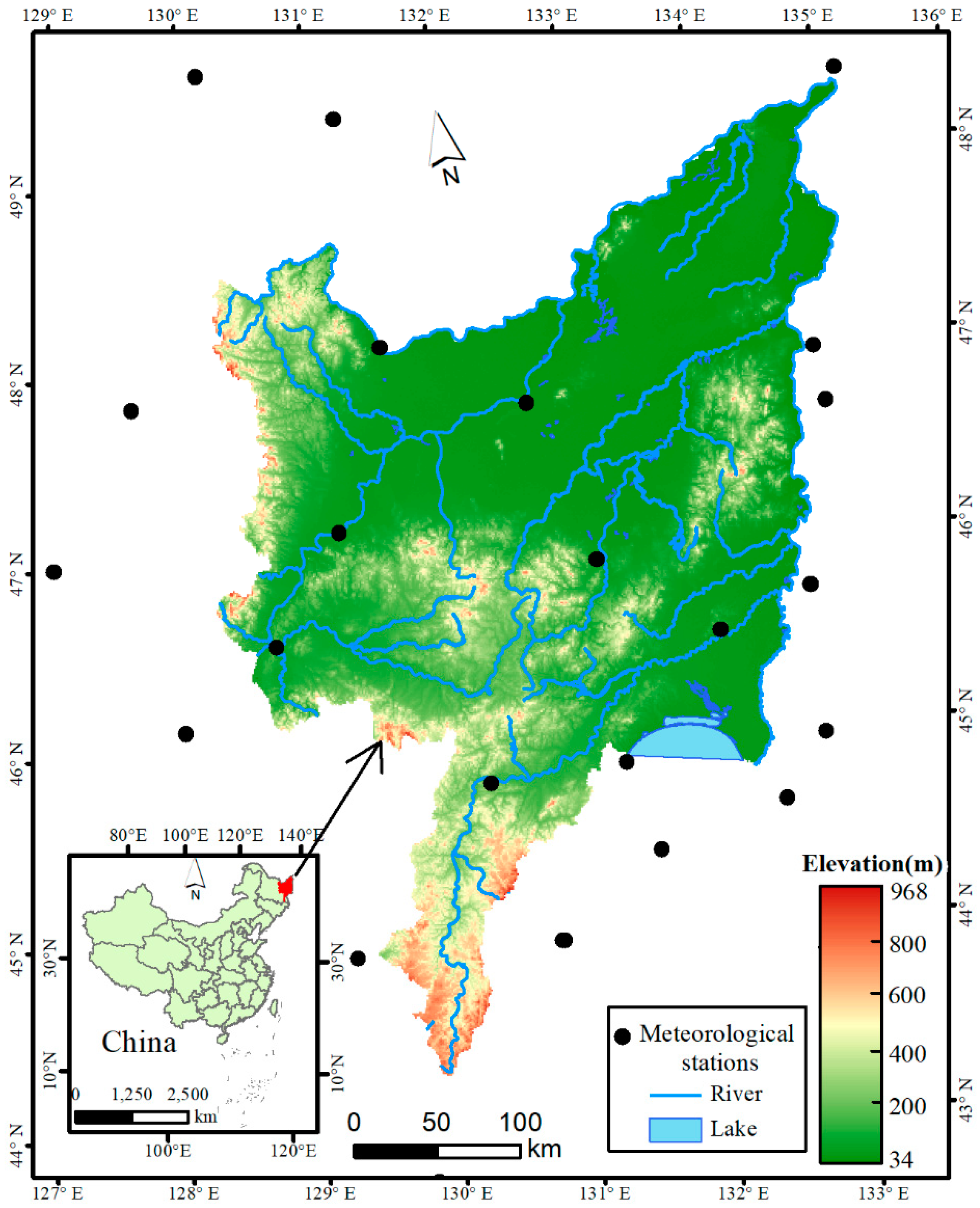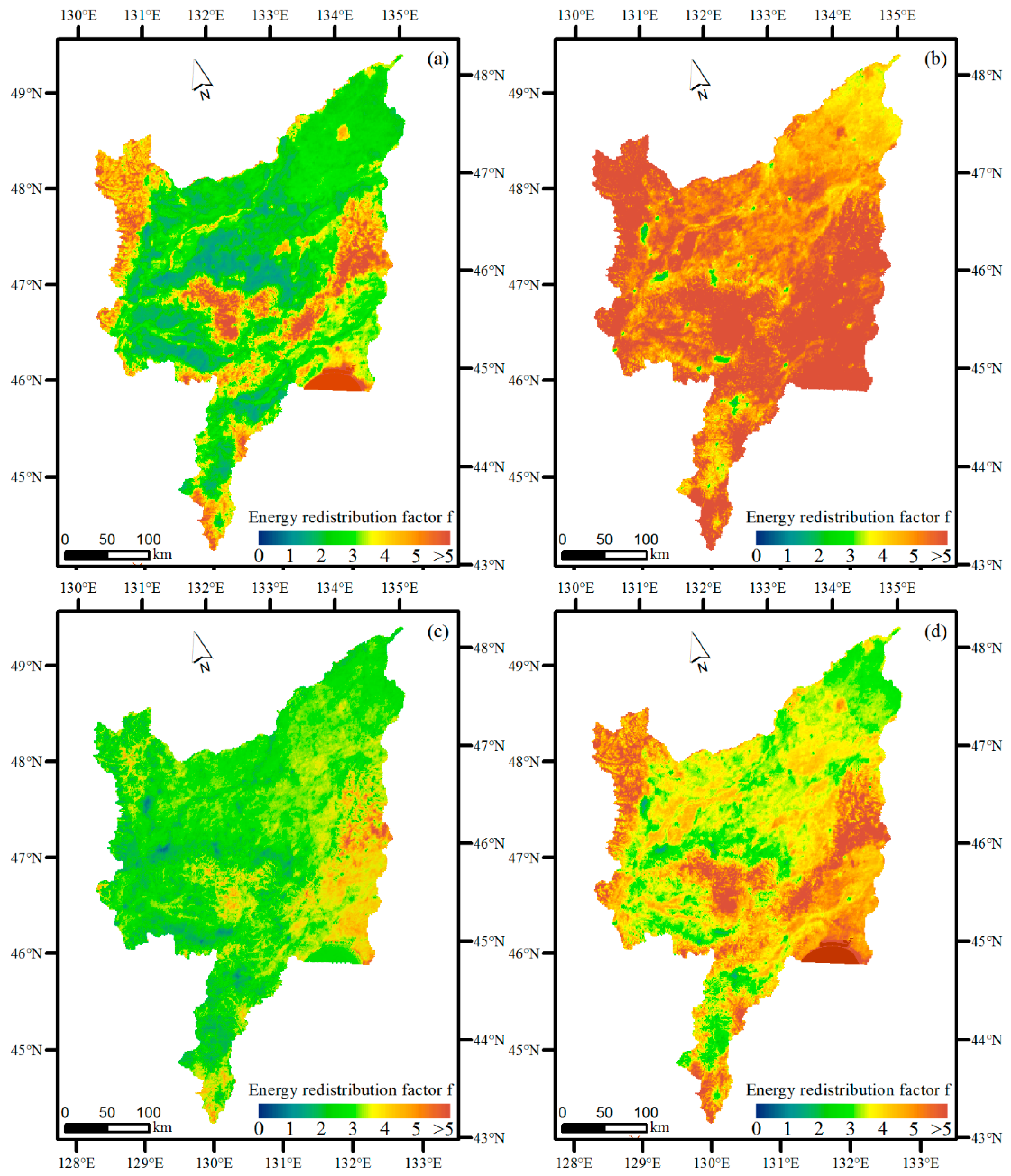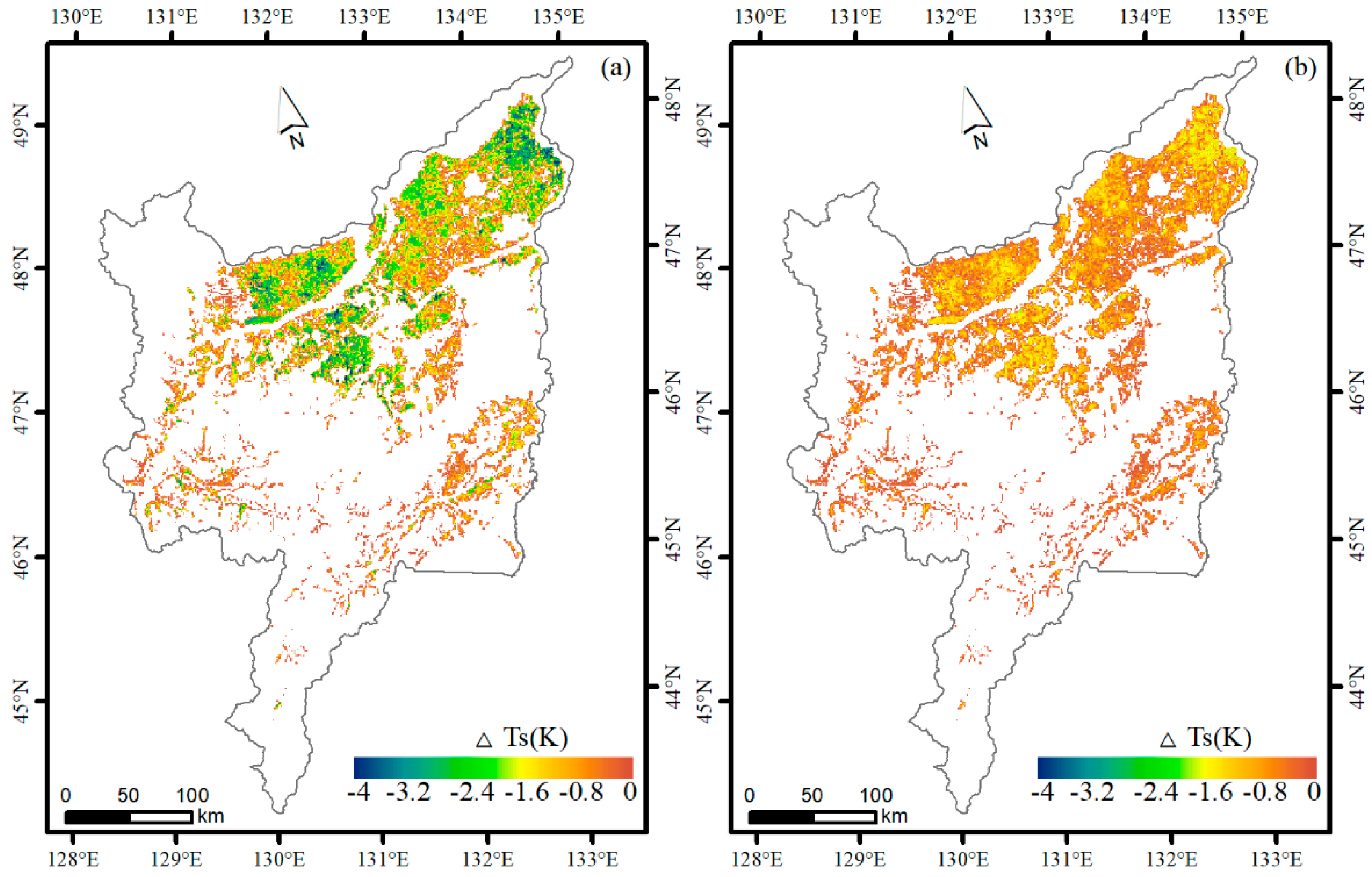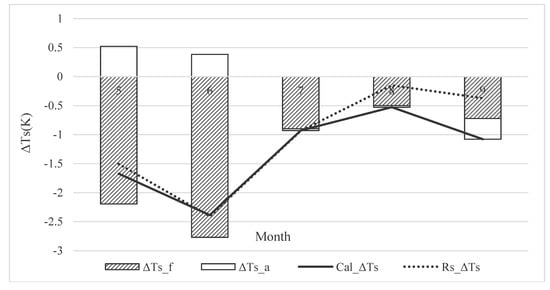Seasonal Local Temperature Responses to Paddy Field Expansion from Rain-Fed Farmland in the Cold and Humid Sanjiang Plain of China
Abstract
1. Introduction
2. Materials and Methods
2.1. Study Area
2.2. Data Processing
2.3. Methodology
2.3.1. Energy Redistribution Factor
2.3.2. Surface Temperature Changes to LUC
2.3.3. Uncertainty Analysis
3. Results
3.1. Paddy Field Expansion in the Sanjiang Plain
3.2. Comparison of Key Biogeophysical Parameters in Rain-Fed Farmland and Paddy Fields
3.3. Energy Redistribution Factor f
3.4. Land Surface Temperature Responses (ΔTs) to Paddy Fields Expansion and Its Contributors
4. Discussion
4.1. The Uncertainties of ΔTs at the Pixel Level
4.2. The Energy Redistribution Factor on the Local Scale
4.3. Temperature Responses from Different Irrigation Types and Different Regions
4.4. Future Studies
5. Conclusions
Supplementary Materials
Author Contributions
Funding
Acknowledgments
Conflicts of Interest
References
- Feddema, J.J.; Oleson, K.W.; Bonan, G.B.; Mearns, L.O.; Buja, L.E.; Meehl, G.A.; Washington, W.M. The Importance of Land-Cover Change in Simulating Future Climates. Science 2005, 310, 1674–1678. [Google Scholar] [CrossRef] [PubMed]
- Betts, R. Implications of Land Ecosystem-Atmosphere Interactions for Strategies for Climate Change Adaptation and Mitigation. Tellus Ser. B Chem. Phys. Meteorol. 2007, 59, 602–615. [Google Scholar] [CrossRef]
- Lee, X.; Goulden, M.L.; Hollinger, D.Y.; Barr, A.; Black, T.A.; Bohrer, G.; Bracho, R.; Drake, B.; Goldstein, A.; Gu, L.H.; et al. Observed Increase in Local Cooling Effect of Deforestation at Higher Latitudes. Nature 2011, 479, 384–387. [Google Scholar] [CrossRef]
- DeFries, R.S.; Bounoua, L.; Collatz, G.J. Human Modification of the Landscape and Surface Climate in the Next Fifty Years. Glob. Chang. Boil. 2002, 8, 438–458. [Google Scholar] [CrossRef]
- Hanna, S.; Marciotto, E.; Britter, R. Urban Energy Fluxes in Built-up Downtown Areas and Variations across the Urban Area, for Use in Dispersion Models. J. Appl. Meteorol. Climatol. 2011, 50, 1341–1353. [Google Scholar] [CrossRef]
- Yu, L.X.; Zhang, S.W.; Tang, J.M.; Liu, T.X.; Bu, K.; Yan, F.Q.; Yang, C.B.; Yang, J.C. The Effect of Deforestation on the Regional Temperature in Northeastern China. Theor. Appl. Climatol. 2015, 120, 761–771. [Google Scholar] [CrossRef]
- Arnfield, A.J. Two Decades of Urban Climate Research: A Review of Turbulence, Exchanges of Energy and Water, and the Urban Heat Island. Int. J. Climatol. 2003, 23, 1–26. [Google Scholar] [CrossRef]
- Davin, E.L.; de Noblet-Ducoudre, N. Climatic Impact of Global-Scale Deforestation: Radiative Versus Non-radiative Processes. J. Clim. 2010, 23, 97–112. [Google Scholar] [CrossRef]
- Mahmood, R.; Pielke, R.A.; Hubbard, K.G.; Niyogi, D.; Dirmeyer, P.A.; McAlpine, C.; Carleton, A.M.; Hale, R.; Gameda, S.; Beltran-Przekurat, A.; et al. Land Cover Changes and Their Biogeophysical Effects on Climate. Int. J. Clim. 2014, 34, 929–953. [Google Scholar] [CrossRef]
- Friedlingstein, P.; Dufresne, J.L.; Cox, P.M.; Rayner, P. How Positive Is the Feedback between Climate Change and the Carbon Cycle? Tellus Ser. B Chem. Phys. Meteorol. 2003, 55, 692–700. [Google Scholar] [CrossRef]
- Chen, L.; Dirmeyer, P.A. Adapting Observationally Based Metrics of Biogeophysical Feedbacks from Land Cover/Land Use Change to Climate Modeling. Environ. Res. Lett. 2016, 11, 034002. [Google Scholar] [CrossRef]
- Bonan, G.B. Forests and Climate Change: Forcings, Feedbacks, and the Climate Benefits of Forests. Science 2008, 320, 1444–1449. [Google Scholar] [CrossRef]
- Winckler, J.; Reick, C.H.; Pongratz, J. Robust Identification of Local Biogeophysical Effects of Land-Cover Change in a Global Climate Model. J. Clim. 2017, 30, 1159–1176. [Google Scholar] [CrossRef]
- Findell, K.L.; Shevliakova, E.; Milly, P.C.D.; Stouffer, R.J. Modeled Impact of Anthropogenic Land Cover Change on Climate. J. Clim. 2007, 20, 3621–3634. [Google Scholar] [CrossRef]
- Bright, R.M. Metrics for Biogeophysical Climate Forcings from Land Use and Land Cover Changes and Their Inclusion in Life Cycle Assessment: A Critical Review. Environ. Sci. Technol. 2015, 49, 3291–3303. [Google Scholar] [CrossRef] [PubMed]
- Pal, J.S.; Giorgi, F.; Bi, X.Q.; Elguindi, N.; Solmon, F.; Gao, X.J.; Rauscher, S.A.; Francisco, R.; Zakey, A.; Winter, J.; et al. Regional Climate Modeling for the Developing World—The Ictp RegCM3 and Regcnet. Bull. Am. Meteorol. Soc. 2007, 88, 1395–1410. [Google Scholar] [CrossRef]
- Lawrence, P.J.; Chase, T.N. Investigating the Climate Impacts of Global Land Cover Change in the Community Climate System Model. Int. J. Climatol. 2010, 30, 2066–2087. [Google Scholar] [CrossRef]
- Pielke, R.A.; Pitman, A.; Niyogi, D.; Mahmood, R.; McAlpine, C.; Hossain, F.; Goldewijk, K.K.; Nair, U.; Betts, R.; Fall, S.; et al. Land Use/Land Cover Changes and Climate: Modeling Analysis and Observational Evidence. Wiley Interdiscip. Rev. Clim. Chang. 2011, 2, 828–850. [Google Scholar] [CrossRef]
- Li, Y.; Zhao, M.S.; Motesharrei, S.; Mu, Q.Z.; Kalnay, E.; Li, S.C. Local Cooling and Warming Effects of Forests Based on Satellite Observations. Nat. Commun. 2015, 6, 6603. [Google Scholar] [CrossRef] [PubMed]
- Pielke, R.A.; Adegoke, J.O.; Chase, T.N.; Marshall, C.H.; Matsui, T.; Niyogi, D. A New Paradigm for Assessing the Role of Agriculture in the Climate System and in Climate Change. Agric. For. Meteorol. 2007, 142, 234–254. [Google Scholar] [CrossRef]
- Bright, R.M.; Davin, E.; O’Halloran, T.; Pongratz, J.; Zhao, K.G.; Cescatti, A. Local Temperature Response to Land Cover and Management Change Driven by Non-Radiative Processes. Nat. Clim. Chang. 2017, 7, 296–303. [Google Scholar] [CrossRef]
- Zhao, L.; Lee, X.; Smith, R.B.; Oleson, K. Strong Contributions of Local Background Climate to Urban Heat Islands. Nature 2014, 511, 216–219. [Google Scholar] [CrossRef] [PubMed]
- Kueppers, L.M.; Snyder, M.A.; Sloan, L.C. Irrigation Cooling Effect: Regional Climate Forcing by Land-Use Change. Geophys. Res. Lett. 2007, 34. [Google Scholar] [CrossRef]
- Puma, M.J.; Cook, B.I. Effects of Irrigation on Global Climate During the 20th Century. J. Geophys. Res. Atmos. 2010, 115. [Google Scholar] [CrossRef]
- Sacks, W.J.; Cook, B.I.; Buenning, N.; Levis, S.; Helkowski, J.H. Effects of Global Irrigation on the near-Surface Climate. Clim. Dyn. 2009, 33, 159–175. [Google Scholar] [CrossRef]
- Bonfils, C.; Lobell, D. Empirical Evidence for a Recent Slowdown in Irrigation-Induced Cooling. Proc. Natl. Acad. Sci. USA 2007, 104, 13582–13587. [Google Scholar] [CrossRef] [PubMed]
- Lobell, D.B.; Bonfils, C.; Faures, J.M. The Role of Irrigation Expansion in Past and Future Temperature Trends. Earth Interact. 2008, 12, 1–11. [Google Scholar] [CrossRef]
- Diffenbaugh, N.S. Influence of Modern Land Cover on the Climate of the United States. Clim. Dyn. 2009, 33, 945–958. [Google Scholar] [CrossRef]
- Cook, B.I.; Shukla, S.P.; Puma, M.J.; Nazarenko, L.S. Irrigation as an Historical Climate Forcing. Clim. Dyn. 2015, 44, 1715–1730. [Google Scholar] [CrossRef]
- Lobell, D.; Bala, G.; Mirin, A.; Phillips, T.; Maxwell, R.; Rotman, D. Regional Differences in the Influence of Irrigation on Climate. J. Clim. 2009, 22, 2248–2255. [Google Scholar] [CrossRef]
- Alter, R.E.; Douglas, H.C.; Winter, J.M.; Eltahir, E.A.B. Twentieth Century Regional Climate Change During the Summer in the Central United States Attributed to Agricultural Intensification. Geophys. Res. Lett. 2018, 45, 1586–1594. [Google Scholar] [CrossRef]
- Huang, X.Y.; Ullrich, P.A. Irrigation Impacts on California’s Climate with the Variable-Resolution CESM. J. Adv. Model. Earth Syst. 2016, 8, 1151–1163. [Google Scholar] [CrossRef]
- Wu, L.Y.; Feng, J.M.; Miao, W.H. Simulating the Impacts of Irrigation and Dynamic Vegetation over the North China Plain on Regional Climate. J. Geophys. Res. Atmos. 2018, 123, 8017–8034. [Google Scholar] [CrossRef]
- Aegerter, C.; Wang, J.; Ge, C.; Irmak, S.; Oglesby, R.; Wardlow, B.; Yang, H.S.; You, J.S.; Shulski, M. Mesoscale Modeling of the Meteorological Impacts of Irrigation During the 2012 Central Plains Drought. J. Appl. Meteorol. Climatol. 2017, 56, 1259–1283. [Google Scholar] [CrossRef]
- Haddeland, I.; Lettenmaier, D.P.; Skaugen, T. Effects of Irrigation on the Water and Energy Balances of the Colorado and Mekong River Basins. J. Hydrol. 2006, 324, 210–223. [Google Scholar] [CrossRef]
- Saeed, F.; Hagemann, S.; Jacob, D. Impact of Irrigation on the South Asian Summer Monsoon. Geophys. Res. Lett. 2009, 36. [Google Scholar] [CrossRef]
- Douglas, E.M.; Beltran-Przekurat, A.; Niyogi, D.; Pielke, R.A.; Vorosmarty, C.J. The Impact of Agricultural Intensification and Irrigation on Land-Atmosphere Interactions and Indian Monsoon Precipitation—A Mesoscale Modeling Perspective. Glob. Planet. Chang. 2009, 67, 117–128. [Google Scholar] [CrossRef]
- Kanamaru, H.; Kanamitsu, M. Model Diagnosis of Nighttime Minimum Temperature Warming During Summer Due to Irrigation in the California Central Valley. J. Hydrometeorol. 2008, 9, 1061–1072. [Google Scholar] [CrossRef]
- Huber, D.; Mechem, D.; Brunsell, N. The effects of Great Plains irrigation on the surface energy balance, regional circulation, and precipitation. Climate 2014, 2, 103–128. [Google Scholar] [CrossRef]
- Lu, Y.Q.; Harding, K.; Kueppers, L. Irrigation Effects on Land-Atmosphere Coupling Strength in the United States. J. Clim. 2017, 30, 3671–3685. [Google Scholar] [CrossRef]
- Lawston, P.M.; Santanello, J.A.; Zaitchik, B.F.; Rodell, M. Impact of Irrigation Methods on Land Surface Model Spinup and Initialization of WRF Forecasts. J. Hydrometeorol. 2015, 16, 1135–1154. [Google Scholar] [CrossRef]
- Zhou, D.C.; Li, D.; Sun, G.; Zhang, L.X.; Liu, Y.Q.; Hao, L. Contrasting Effects of Urbanization and Agriculture on Surface Temperature in Eastern China. J. Geophys. Res. Atmos. 2016, 121, 9597–9606. [Google Scholar] [CrossRef]
- Yan, F.Q.; Zhang, S.W.; Liu, X.T.; Yu, L.X.; Chen, D.; Yang, J.C.; Yang, C.B.; Bu, K.; Chang, L.P. Monitoring Spatiotemporal Changes of Marshes in the Sanjiang Plain, China. Ecol. Eng. 2017, 104, 184–194. [Google Scholar] [CrossRef]
- Song, K.S.; Wang, Z.M.; Du, J.; Liu, L.; Zeng, L.H.; Ren, C.Y. Wetland Degradation: Its Driving Forces and Environmental Impacts in the Sanjiang Plain, China. Environ. Manag. 2014, 54, 255–271. [Google Scholar] [CrossRef]
- Wang, Z.M.; Zhang, B.; Zhang, S.Q.; Li, X.Y.; Liu, D.W.; Song, K.S.; Li, J.P.; Li, F.; Duan, H.T. Changes of Land Use and of Ecosystem Service Values in Sanjiang Plain, Northeast China. Environ. Monit. Assess. 2006, 112, 69–91. [Google Scholar] [CrossRef]
- Zhang, S.W.; Zhang, Y.Z.; Li, Y.; Chang, L.P. Temporal and Spatial Characteristics of Land Use/Cover in Northeast China; Science Press: Beijing, China, 2006. [Google Scholar]
- Zhang, J.Y.; Ma, K.M.; Fu, B.J. Wetland Loss under the Impact of Agricultural Development in the Sanjiang Plain, Ne China. Environ. Monit. Assess. 2010, 166, 139–148. [Google Scholar] [CrossRef]
- Yan, F.Q.; Zhang, S.W.; Liu, X.T.; Chen, D.; Chen, J.; Bu, K.; Yang, J.C.; Chang, L.P. The Effects of Spatiotemporal Changes in Land Degradation on Ecosystem Services Values in Sanjiang Plain, China. Remote Sens. 2016, 8, 917. [Google Scholar] [CrossRef]
- Yan, F.Q.; Yu, L.X.; Yang, C.B.; Zhang, S.W. Paddy Field Expansion and Aggregation since the Mid-1950s in a Cold Region and Its Possible Causes. Remote Sens. 2018, 10, 384. [Google Scholar] [CrossRef]
- Liu, J.Y.; Liu, M.L.; Deng, X.Z. The Land Use and Land Cover Change Database and Its Relative Studies in China. J. Geogr. Sci. 2002, 12, 275–282. [Google Scholar]
- Wang, C.Y.; Yang, J.C.; Myint, S.W.; Wang, Z.H.; Tong, B. Empirical Modeling and Spatio-Temporal Patterns of Urban Evapotranspiration for the Phoenix Metropolitan Area, Arizona. GIsci. Remote Sens. 2016, 53, 778–792. [Google Scholar] [CrossRef]
- Mu, Q.Z.; Zhao, M.S.; Running, S.W. Improvements to a Modis Global Terrestrial Evapotranspiration Algorithm. Remote Sens. Environ. 2011, 115, 1781–1800. [Google Scholar] [CrossRef]
- Yu, L.X.; Liu, T.X.; Cai, H.Y.; Tang, J.M.; Bu, K.; Yan, F.Q.; Yang, C.B.; Yang, J.C.; Zhang, S.W. Estimating Land Surface Radiation Balance Using Modis in Northeastern China. J. Appl. Remote Sens. 2014, 8, 083523. [Google Scholar] [CrossRef]
- Gelaro, R.; Mccarty, W.; Suárez, M.J.; Todling, R.; Molod, A.; Takacs, L.; Randles, C.; Darmenov, A.; Bosilovich, M.; Reichle, R. The Modern-Era Retrospective Analysis for Research and Applications, Version 2 (MERRA-2). J. Clim. 2017, 30, 5419–5454. [Google Scholar] [CrossRef]
- Juang, J.Y.; Katul, G.; Siqueira, M.; Stoy, P.; Novick, K. Separating the Effects of Albedo from Eco-Physiological Changes on Surface Temperature along a Successional Chronosequence in the Southeastern United States. Geophys. Res. Lett. 2007, 34. [Google Scholar] [CrossRef]
- Vanden Broucke, S.; Luyssaert, S.; Davin, E.L.; Janssens, I.; van Lipzig, N. New Insights in the Capability of Climate Models to Simulate the Impact of Luc Based on Temperature Decomposition of Paired Site Observations. J. Geophys. Res. Atmos. 2015, 120, 5417–5436. [Google Scholar] [CrossRef]
- Fischer, G.; Nachtergaele, F.O.; Prieler, S.; Teixeira, E.; Toth, G.; van Velthuizen, H.T.; Verelst, L.; Wiberg, D. Global Agro-Ecological Zones (GAEZ v3.0); IIASA: Laxenburg, Austria; FAO: Rome, Italy, 2012. [Google Scholar]
- Pielke, R.A.; Marland, G.; Betts, R.A.; Chase, T.N.; Eastman, J.L.; Niles, J.O.; Niyogi, D.D.S.; Running, S.W. The Influence of Land-Use Change and Landscape Dynamics on the Climate System: Relevance to Climate-Change Policy Beyond the Radiative Effect of Greenhouse Gases. Philos. Trans. Math. Phys. Eng. Sci. 2002, 360, 1705–1719. [Google Scholar] [CrossRef] [PubMed]
- Yu, L.X.; Liu, T.X.; Bu, K.; Yang, J.C.; Chang, L.P.; Zhang, S.W. Influence of Snow Cover Changes on Surface Radiation and Heat Balance Based on the WRF Model. Theor. Appl. Climatol. 2017, 130, 205–215. [Google Scholar] [CrossRef]
- Kueppers, L.M.; Snyder, M.A.; Sloan, L.C.; Cayan, D.; Jin, J.; Kanamaru, H.; Kanamitsu, M.; Miller, N.L.; Tyree, M.; Due, H.; et al. Seasonal Temperature Responses to Land-Use Change in the Western United States. Glob. Planet. Chang. 2008, 60, 250–264. [Google Scholar] [CrossRef]
- Fan, X.G.; Ma, Z.G.; Yang, Q.; Han, Y.H.; Mahmood, R.; Zheng, Z.Y. Land Use/Land Cover Changes and Regional Climate over the Loess Plateau During 2001–2009. Part I: Observational Evidence. Clim. Chang. 2015, 129, 427–440. [Google Scholar] [CrossRef]
- Himiyama, Y. Land-Use Change and Regional Development in Hokkaido. In Land Use Changes in Comparative Perspective; Himiyama, Y., Hwang, M., Ichinose, T., Eds.; Science Publishers, Inc.: Plymouth, UK, 2002. [Google Scholar]
- Ramankutty, N.; Foley, J.A. Estimating Historical Changes in Global Land Cover: Croplands from 1700 to 1992. Glob. Biogeochem. Cycles 1999, 13, 997–1027. [Google Scholar] [CrossRef]
- Zhang, X.Z.; Xiong, Z.; Tang, Q.H. Modeled Effects of Irrigation on Surface Climate in the Heihe River Basin, Northwest China. J. Geophys. Res. Atmos. 2017, 122, 7881–7895. [Google Scholar] [CrossRef]
- Selman, C.; Misra, V. The Impact of an Extreme Case of Irrigation on the Southeastern United States Climate. Clim. Dyn. 2017, 48, 1309–1327. [Google Scholar] [CrossRef]
- Sorooshian, S.; Li, J.L.; Hsu, K.L.; Gao, X.G. How Significant Is the Impact of Irrigation on the Local Hydroclimate in California’s Central Valley? Comparison of Model Results with Ground and Remote-Sensing Data. J. Geophys. Res. Atmos. 2011, 116. [Google Scholar] [CrossRef]
- Liu, Y.; Sheng, L.X.; Liu, J.P. Impact of Wetland Change on Local Climate in Semi-Arid Zone of Northeast China. Chin. Geogr. Sci. 2015, 25, 309–320. [Google Scholar] [CrossRef]
- Natuhara, Y. Ecosystem Services by Paddy Fields as Substitutes of Natural Wetlands in Japan. Ecol. Eng. 2013, 56, 97–106. [Google Scholar] [CrossRef]
- Zhou, Y.T.; Xiao, X.M.; Qin, Y.W.; Dong, J.W.; Zhang, G.L.; Kou, W.L.; Jin, C.; Wang, J.; Li, X.P. Mapping Paddy Rice Planting Area in Rice-Wetland Coexistent Areas through Analysis of Landsat 8 Oli and Modis Images. Int. J. Appl. Earth Obs. Geoinf. 2016, 46, 1–12. [Google Scholar] [CrossRef] [PubMed]
- Kundzewicz, Z.W.; Doll, P. Will Groundwater Ease Freshwater Stress under Climate Change? Hydrol. Sci. J. 2009, 54, 665–675. [Google Scholar] [CrossRef]






| Land Type/Month | May | June | July | August | September | Growing Season |
|---|---|---|---|---|---|---|
| Paddy Fields | 2.28 | 3.15 | 5.70 | 5.16 | 2.74 | 3.81 |
| Rain-Fed Land | 1.42 | 1.79 | 4.26 | 4.31 | 2.06 | 2.77 |
| Δf | 0.87 | 1.36 | 1.43 | 0.85 | 0.68 | 1.04 |
© 2018 by the authors. Licensee MDPI, Basel, Switzerland. This article is an open access article distributed under the terms and conditions of the Creative Commons Attribution (CC BY) license (http://creativecommons.org/licenses/by/4.0/).
Share and Cite
Liu, T.; Yu, L.; Bu, K.; Yan, F.; Zhang, S. Seasonal Local Temperature Responses to Paddy Field Expansion from Rain-Fed Farmland in the Cold and Humid Sanjiang Plain of China. Remote Sens. 2018, 10, 2009. https://doi.org/10.3390/rs10122009
Liu T, Yu L, Bu K, Yan F, Zhang S. Seasonal Local Temperature Responses to Paddy Field Expansion from Rain-Fed Farmland in the Cold and Humid Sanjiang Plain of China. Remote Sensing. 2018; 10(12):2009. https://doi.org/10.3390/rs10122009
Chicago/Turabian StyleLiu, Tingxiang, Lingxue Yu, Kun Bu, Fengqin Yan, and Shuwen Zhang. 2018. "Seasonal Local Temperature Responses to Paddy Field Expansion from Rain-Fed Farmland in the Cold and Humid Sanjiang Plain of China" Remote Sensing 10, no. 12: 2009. https://doi.org/10.3390/rs10122009
APA StyleLiu, T., Yu, L., Bu, K., Yan, F., & Zhang, S. (2018). Seasonal Local Temperature Responses to Paddy Field Expansion from Rain-Fed Farmland in the Cold and Humid Sanjiang Plain of China. Remote Sensing, 10(12), 2009. https://doi.org/10.3390/rs10122009





